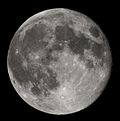- Selenoplexia
-
Selenoplexia (or selenoplegia, selenoplege, moonstroke), from the Greek words selene, the moon, and plexis, stroke), was a medical term used to described an “apoplectic state,”[1] a “morbid state”[2] or “diseased condition”[3] whose supposed cause were the rays of the moon. A Dictionary of Medical Science (1895), in its discussion of the conditions of sunstroke, writes that the “morbid phenomena observable after death are generally those of nervous exhaustion, neuroparalysis. Like effects have also been ascribed to the moon, selenoplexia, selenoplege, moonstroke; and to the stars, starstroke.” [4]
References
- ^ Lippincott's Medical dictionary (Lippincott, 1906), p. 920.
- ^ William Dwight Whitney, Benjamin Eli Smith (editors), The Century Dictionary and Cyclopedia, Volume 8 of The Century Dictionary and Cyclopedia: With a New Atlas of the World; a Work of General Reference in All Departments of Knowledge. Volume 8 of The Century Dictionary and Cyclopedia: With a New Atlas of the World (The Century co., 1911), 5733.
- ^ The American Illustrated Medical Dictionary (Saunders, 1922), p. 933
- ^ Robley Dunglison; Richard James Dunglison (ed.), A dictionary of medical science (Lea Brothers & Co., 1895), 282.
The Moon Physical features 
Orbit Lunar surface - Selenography
- Near side
- Far side
- Lunar mare
- (List)
- Craters
- (List)
- Mountains
- Valleys
- South Pole – Aitken basin
- Shackleton crater
- Water
- Soil
- Peak of eternal light
- Space weathering
- Transient lunar phenomenon
Lunar science Exploration Other topics - See also Solar System
- Natural satellite
Wikimedia Foundation. 2010.
